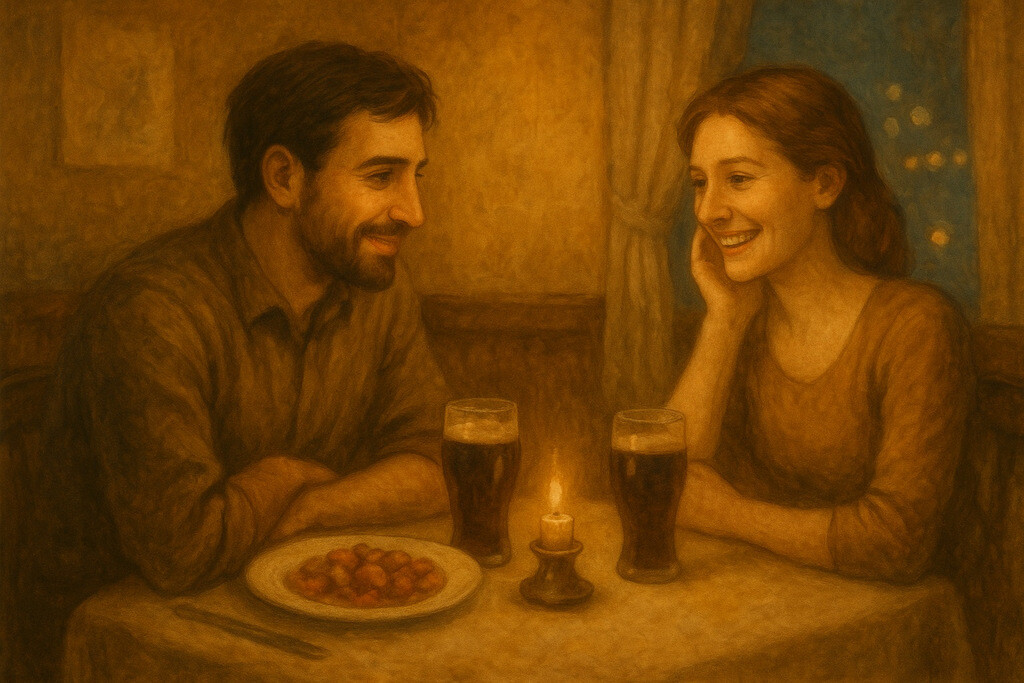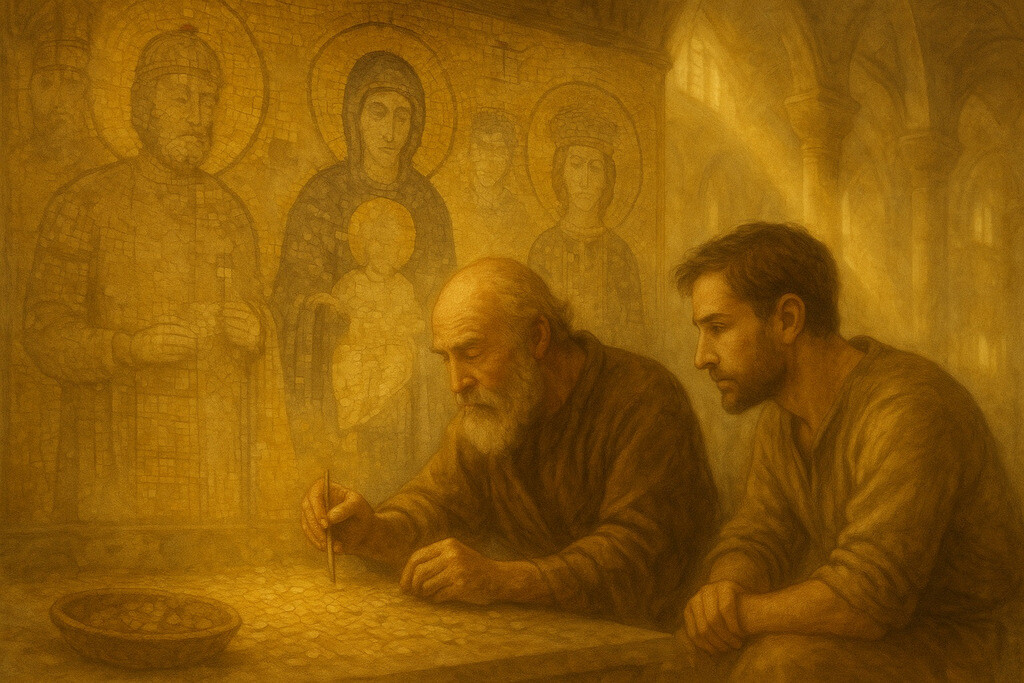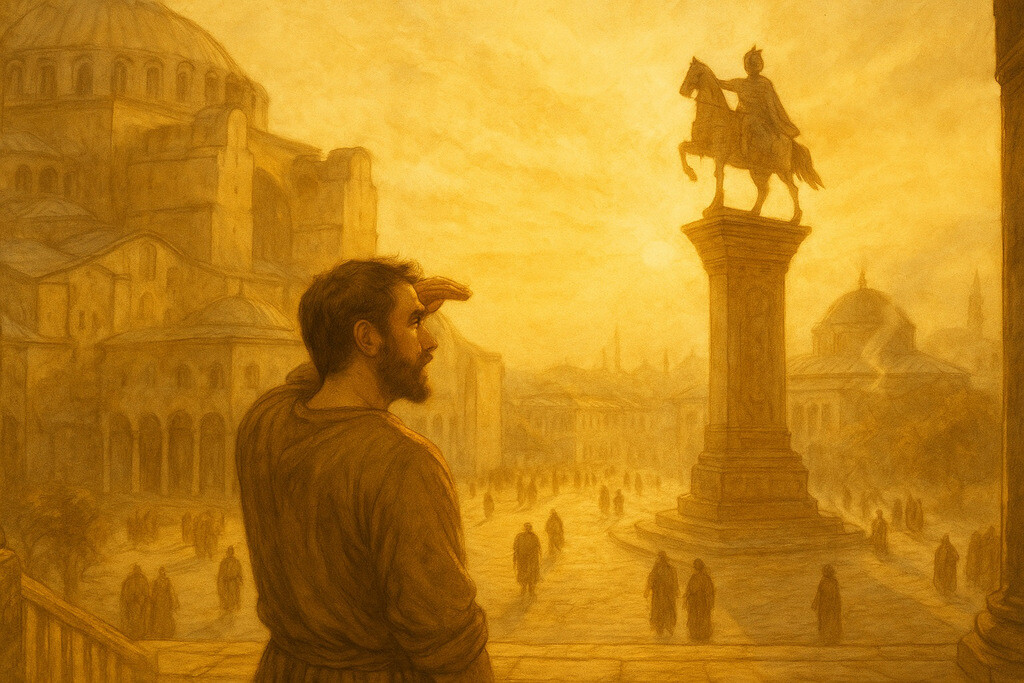There are dreams that refuse to fade with daylight.
They linger in the corners of vision, disguised as memory, disguised as thought — following a man through the hum of traffic, the glare of screens, the quiet rhythm of his own breathing.
Stavros had carried one of those dreams into morning, and the world around him, though modern and loud, now seemed built upon invisible ruins.
The dream did not end with the battle. It followed him home.
The Mirror of the Modern Empire
The morning after the dream had already dissolved into the rhythm of deadlines and screens.
In the glass-walled office on Madison Avenue, Stavros sat before a grid of glowing monitors while a dozen voices traded ideas about color palettes, fonts, and campaign slogans. Outside, the October sky stretched like a cold sheet of steel over Manhattan. Inside, he played his role: creative director, mentor, decision-maker, the man who knew how to make beauty sell.
Yet somewhere behind his calm gestures and precise words, the clang of armor still echoed. Every time he adjusted the hue of a digital sky or approved a new layout, he remembered another kind of sky—the smoky bronze light over the mountains of Pliska, the glitter of spearheads in the dawn.
It unnerved him how easily the mind could hold two centuries at once.
When evening came, he closed his laptop and let the office empty around him. The city lights began to bloom like constellations reflected on wet asphalt. He met Anna at a restaurant near Bryant Park—a small Hungarian place she liked for its paprika stew and dark beer.
Anna worked in finance, her days measured in numbers and market swings. She had the kind of brisk intelligence that steadied him, yet that night, as she spoke about quarterly projections, he found his thoughts drifting elsewhere. Anna. How many Annas had walked the corridors of Byzantine palaces? Empress Anna Dalassene, Anna Komnene the historian, Anna of Savoy—the name itself seemed woven into the empire’s long tapestry.
“Are you listening?” she asked, smiling over her glass.
He blinked, apologetic. “Sorry—just thinking about history again.”
She laughed softly. “Of course you are. With you, it’s always half the present and half Constantinople.”

Later, back in his apartment, he stood before the icon his mother had painted—Saint Nicholas, halo cracked by time—and felt that same quiet pull between worlds. He opened Byzantium: The Decline and Fall, flipping through the pages until he found the passage on Emperor John II Komnenos and his Hungarian wife, Irene. A note in the margin—written long ago in his own hand—caught his eye: The union of East and West, sealed in mosaic.
Curious, he searched for the Hagia Sophia mosaic that immortalized their faces. The image appeared on his screen: John II with his serene, severe gaze; Irene beside him, fair-haired, offering a scroll to the Virgin. Stavros stared until the room dissolved into shadow. The last thing he saw before sleep was that luminous gold background—like a gate slowly opening.
Within the Mosaic of Time
He woke into light—not daylight, but the radiant shimmer of tesserae.
His hands were smaller, rougher, dusted with gold and plaster. A mosaic hammer lay across his palm. Around him rose the vast interior of Hagia Sophia, its upper gallery bathed in honeyed sunlight filtering through high arched windows. He could smell lime mortar and candle wax.
A voice beside him—aged, patient, accented by the city—said, “Careful with that line, boy. The Emperor’s robe must flow as if the Spirit breathes through it.”
Stavros turned. His master stood over him, an old mosaicist with eyes bright as molten glass. Together they worked on the panel depicting Emperor John II and Empress Irene, the couple presenting gifts to the Virgin and Child.

When the master stepped back to judge the work, Stavros let his gaze wander. Across the gallery gleamed an older mosaic: Empress Zoe and Constantine IX Monomachos, stiff yet somehow alive, their jeweled robes catching the light. The gold background rippled like a living sea.
He felt the strange vertigo of déjà vu—a recognition that came not from memory but from destiny. As he studied the faces, a rustle of fabric drew his attention. Turning, he found himself face to face with Emperor John II Komnenos himself.
The ruler’s presence was commanding yet humane; the scent of incense clung to his cloak of deep crimson. He looked not at Stavros but at the mosaic, nodding in approval.
“The blue,” the Emperor said, addressing the master. “You have captured the very shade of heaven.”
The old craftsman bowed low. “Your Majesty, it is the Virgin who lends us her light.”
Stavros could not speak. He felt the weight of centuries compress around him—the heartbeat of an empire, the hum of prayers rising from marble floors far below.
When the work was done, he followed his master out through the great doors of Hagia Sophia.
Sunlight struck his eyes as they stepped into the Augustaion, the grand square before the church. The city unfolded before him like a vision newly born: the Senate House to one side, the Baths of Zeuxippus steaming in the distance, and at the center a towering column crowned by the equestrian statue of Justinian the Great, his bronze hand raised toward heaven.

Stavros stood there, awed.
For the first time in all his dreams, he had left the sacred interior and touched the living streets of Constantinople. The air smelled of the sea and spiced bread, of incense and horse sweat. He began to walk—past merchants calling in Greek, Armenian, and Latin; past pilgrims kneeling on the paving stones; past soldiers whose armor gleamed like fish scales under the sun.
Down the Mese, the city’s grand avenue, he walked as if through the corridors of his own mind. Every stone seemed to remember something, and he could feel their whispers beneath his feet.
He reached the Forum of Constantine, where the great porphyry column rose spiraling into the light, the relics of saints sealed within. He looked up—and in that instant, a faint mechanical chirp broke the spell.
Beep… beep… beep.
His wristwatch.
The forum vanished. The marble colonnades melted into the dull white ceiling of his bedroom. Morning light poured in. For a moment, he lay still, his pulse racing, the taste of dust and incense still in his throat. Then he smiled.
Each dream was carrying him further—first the battlefield, now the heart of the Empire’s glory. Somewhere between history and sleep, Byzantium was rebuilding itself, tile by tile, inside him.
He rose, washed his face, and caught his reflection in the mirror: a man both modern and ancient, bound by invisible threads to worlds that refused to stay dead.
Outside, the city waited.
And perhaps tonight, when the lights dimmed again, the mosaics would open once more.
Historical Background
The mosaic in Hagia Sophia mentioned in this episode, and the figures within it—Emperor John II Komnenos and Empress Irene—were inspired by real history. You can find more detailed information below.
John II Komnenos (r. 1118 – 1143)
John II Komnenos, also known as John the Beautiful and the Merciful, was the son of Emperor Alexios I Komnenos and Irene Doukaina. His long reign marked one of the most stable and prosperous periods of the later Byzantine Empire. Renowned for his piety and restraint, John II restored imperial authority in Anatolia and pursued campaigns against the Pechenegs, Seljuks, and Crusader principalities with cautious brilliance. He died in 1143 during a hunting accident in Cilicia, leaving behind a legacy of justice and moderation.
Irene of Hungary (Piroska, Empress of the Romans)
Born Piroska, daughter of King Ladislaus I of Hungary, she married John II Komnenos around 1104 and took the name Irene (“Peace”) upon conversion to Orthodoxy. Deeply religious and charitable, she founded the Monastery of Christ Pantokrator in Constantinople, later used as the burial site for the Komnenian dynasty. Her union with John II symbolized a diplomatic bridge between Byzantium and Central Europe. She was canonized by the Orthodox Church as Saint Irene of Hungary.
The Mosaic of John II and Irene – Hagia Sophia
Located in the upper south gallery of Hagia Sophia, this mosaic was created around 1122. It depicts the Virgin Mary holding the Christ Child, flanked by Emperor John II offering a purse (symbolizing donations) and Empress Irene offering a scroll. Their son, the co-emperor Alexios Komnenos, appears beside them. The work reflects the refined naturalism and spiritual depth of Komnenian art, continuing the tradition of imperial devotion established by the earlier mosaic of Empress Zoe and Constantine IX.
To be continued
The journey through Byzantium has only begun.
From the smoke and terror of Pliska (you can find the previous Episode I here) to the golden stillness of Hagia Sophia, Stavros’s dreams are drawing him deeper into the empire’s heart — from battlefields to mosaics, from memory to revelation.
Somewhere ahead lies the true face of Constantinople, waiting for him beneath layers of time and sleep.
To be continued…